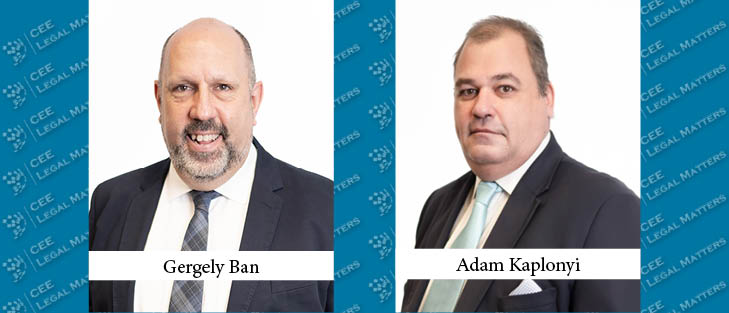Despite 2024 being a relatively slow year in terms of real estate transactions, Act Legal Partners Adam Kaplonyi and Gergely Ban see ample signs to be optimistic about the sector's outlook in Hungary.
CEELM: What have been the real estate sectors that have seen the most transactional activity this past year in Hungary?
Kaplonyi: To be honest, 2024 has not seen many transactions – something that is generally true for the entire real estate market, not just for a specific sector. The volume of investments has been decreasing in the entire Hungarian economy. At the same time, there are some promising activities, new developments, and opportunities in certain market sectors, which I think may lead to a new wave of transactions soon.
Ban: I think that despite all the evident economic difficulties in Hungary and generally in the world, there are always some market players who can adapt and succeed. Thanks to our clients we already see specific prospective projects in the pipeline, some may even start this year.
CEELM: While accounting for the slowdown, which sectors have been most active in the country in terms of new developments/projects and why do you believe that was the case?
Ban: The hospitality sector has great potential, Hungary has traditionally been a popular target for tourists, and, now that the pandemic is over, it seems that tourism has fully recovered and will continue growing. Several new hotels (among them luxury ones) were completed in the course of 2023 and 2024 and I expect new developments to come. For example, in Budapest, there are still fantastic buildings out there with great potential waiting for a thorough refurbishment.
Kaplonyi: Logistics certainly seems to be another strong sector. The continuous increase in warehouse areas was originally triggered by growth in e-commerce, later accelerated by the pandemic and the changing habits of customers. I am not sure for how long this trend will continue though. As we see it, it is not that difficult to find new tenants for such new buildings at the moment but finding good new locations may not be as easy. I do not see growth potential in classic retail (including plazas and smaller retail units) in the short run. The residential property development market may have had its ups and downs, but owing to the state subsidies provided to people wishing to buy new homes, it is still up and running.
CEELM: Are developments primarily driven by local or international players? What do you believe are the main draw factors for foreign investors in the sector in Hungary?
Ban: The share of local players in developments/investments is definitely increasing. There is now a group of Hungarian entrepreneurs, who, for one reason or another, are capable of implementing significant projects. Many of them are also looking for investment opportunities abroad. However, the largest developers are still international companies.
Kaplonyi: We also have to note that some international players – who we used to think of as an integral and stable part of the Hungarian market – either abandoned Hungary or downsized their portfolios and not all of their assets were purchased by other international investors. Nevertheless, based on discussions with colleagues within Act Legal and with clients, I still see and feel trust in the Hungarian market. There still are newcomers and wannabe newcomers. The main draw factors may vary from sector to sector, but the devaluating Hungarian forint is certainly one of them, especially since almost all commercial rents are paid in euros.
CEELM: Has the shock of labor and material pricing passed or is it still very much felt on the market? If the latter, what’s the realistic time frame you see for it to cool off?
Kaplonyi: Inflation decreased significantly – one might say it is more or less within a normal range now. Officially, it is 3% and, while the actual inflation is probably higher and inflation on costs of materials and labor is definitely higher, it is far less extreme than it was in 2022 or 2023.
Ban: I agree. At the same time, it is worth noting that the devaluation of the Hungarian forint against the euro and US dollar has been a constant trend, which will keep pushing up material prices to some degree.
CEELM: How has the rise of ESG impacted local players? Have you seen them adapt yet or is this evolution still very much an ongoing process?
Kaplonyi: If you mean sustainability in general, the key market players all adapted to the concept. It has been quite a while since a new building was completed without obtaining BREEAM, LEED, or other similar certifications. If one talks about office leases, it has long been a trend that tenants prefer to move into more efficient, more sustainable, more cost-effective buildings. If you mean compliance with recent ESG regulations, most companies are only in the phase of contemplating the “to do”-s rather than “doing,” but at the end of the day they will have no choice but to comply.
Ban: We’ve also seen an increased tendency of foreign companies enforcing their internal ESG policies on their contracting partners (landlords, suppliers, etc). Usually, that’s done on a take-it-or-leave-it basis and they also require their partners to enforce the terms throughout their own supply chain. Not all local companies are prepared to accept this yet. Sooner or later, the new ESG regulations will require this of everyone but the pressure is already there before any law was enacted in Hungary to make them mandatory.
CEELM: From a legislative/regulatory framework, what elements do you believe most supported RE projects in the country? On the flip side, what do you believe have been the biggest barriers to date?
Ban: Bureaucratic procedures are traditionally a problem in Hungary. However, a lot has been done in the past 15-20 years to decrease administrative burdens and simplify procedures. Many processes have been fully digitalized and they indeed become faster, more transparent, and more user-friendly. It is a success story. And such digitalization continues. For example, all land registry procedures will be digitalized from January next year and all registrations will take place without submitting any paper to the authorities. The entire Hungarian administration is undergoing a digital transformation.
Kaplonyi: That said, we are still not great at maintaining a predictable legal environment. Hungarian governments tend to change laws – even fundamental ones – frequently either for short-term gains or because legislative faults (that should have been avoided in the first place) need to be corrected. The effective Civil Code, for example, entered into force 20 years ago but has been amended more than 30 times since then. If the government decides to support some preferred projects, they are not afraid to change the law in support of such projects. A recent general change includes the total reform of the zoning and building regulations and related licensing procedures starting this October, which promises less bureaucracy. We shall see how it works in practice.
CEELM: What is your outlook for the sector in the next 12 months?
Kaplonyi: Everyone is asking whether we have hit rock bottom yet and everyone gives different answers. Based on the activities of market players I am aware of, it seems to me we passed that point, but I can’t know for sure how representative my anecdotal observations are of the market as a whole. Overall, I believe 2025 should see a slow but steady move upward.
Ban: Our clients’ activities will definitely at least keep steady in Hungary. Moreover, we expect that they will bring more promising investments to Hungary in the next 12 months – e.g., expansions of existing facilities. We will be busy in 2025!




